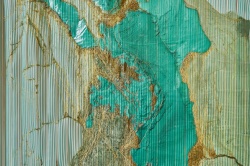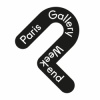Cathryn Boch
Reversefrom May 18 to July 18 - 2019
print

Cathryn Boch, Sans titre (detail), 2019, © Jean-Christophe Lett
Cathryn Boch
Reverse
18 May - 18 July 2019 (closed 19 - 26 June)
Opening Saturday, May 18, 12 - 9 pm
 On the occasion of Paris Gallery Weekend
On the occasion of Paris Gallery Weekend
SUNDAY 19 MAY
12 - 7 pm One-off opening
4 pm - Jazz live & drinks
"I'm leaving from where I am to meet the world" (1).
June 2018. A symbol of Europe's difficulties in dealing with the challenge of migration, the Aquarius is denied access to the Maltese and Italian coasts. The boat and its 629 migrants - men, women, children, rescued at sea - are stuck for several days without being able to dock, before Spain finally decides to welcome them. France’s silence is deafening.
October 2018. Despite protests from the inhabitants, the century-old trees on Place de la Plaine in Marseille are destroyed to make way for a strip of walls to protect construction, a symptom of the gentrification of the Phocean city.
November 2018. Two buildings on rue d'Aubagne in the Noailles district of Marseille collapsed, causing the deaths of 8 people. This drama highlights the dilapidated state of housing in Marseille’s working class neighborhoods.
Living on the border. Living in a building, a neighborhood, a city. Living in a country, a world. Living in a body. Inhabited by these tragic events and social tensions, Cathryn Boch began a residency of research and creation in the autumn of 2018 at the 3bisF - a contemporary art venue located in the Montperrin Psychiatric Hospital Center in Aix-en-Provence - where the works presented today at the Galerie Papillon were created.
Very intense both physically and emotionally, the residency is an opportunity for the artist to begin a new chapter, driven by the urgency to tame her daily life, to exorcise these dramas. An urgent need to create that responds to the social, ecological and humanitarian urgency that we are experiencing and that lives within us. "My drawings are a reflection of my daily life, they are layers. They are waiting to be formed little by little, they deal with the world around them. It is an approach of memory and absolute present" (2).
Cathryn Boch's artistic approach is very close to Gestalt therapy, where the creative act is defined as the ability to transcend the daily struggle for survival. Gestalt, which translates into "form" in the sense of taking shape, organizing, building oneself, is a therapeutic approach centered on the constant interaction of the human being with its environment. It is therefore in connection with her environment, with her place in life, that the artist works with maps of the city of Marseille : the Noailles district, the Place de la Plaine, maritime maps of the Mediterranean, aerial views of the region. A Mediterranean crossroads where deep and sensitive links are forged between France and Europe, North Africa and the Middle East, Marseille is a border city, an open city, a port of welcome, which is gradually closing under the pressure of lively and heated debates on the crisis and reception of migrants. As a metaphor for this geographical in-between, a transparent blue plastic curtain is invaded by threads, as if to find a passage, a way out of these debates strained between two polarities: hospitality and hostility. A powerful and poetic tension cultivated by the artist in her works of exacerbated fragility. The tension of the mishandled, pierced, bent material; the tension of the knotted thread; the tension of the unresolved work, as if it were about to disintegrate, to come apart. The tension of a world shaken by different earthquakes: a migratory crisis, the rise of extremism, wars, global warming ... The dark earth, the continents are eroding in Cathryn Boch’s drawings, where the recurrence of yellow and orange warns us about the world’s decay. These bright colors, new to the artist’s plastic vocabulary, act as warning signs, beacons, underlining tensions, disappointments, of a world that is fading, like the sanded, sewn, mended maps, in an intense body to body, in a necessary movement of thought. In this struggle to tame the material, to tame the world, the artist attacks plastic for the first time to express the urgency of polluted lands, drowned seas, contaminated bodies. In a fragile balance, the paper of the maps crack, the stitches break apart under the weight of the roundness of a balloon, under the tension of a hoop. The plastic elements used bring about a relationship to the body, to space, to movement in a constant back and forth between the macrocosm of the maps and the microcosm of the bodies. It is a movement that is particularly significant in recent works that gain in volume, overflow the frame, detach themselves from the wall, to conquer space, to play with emptiness.
Between drawing, sculpture and installation, the works display vanishing lines, which connect them to space and to the spectator. Thus, the movement of the body of the struggling artist responds to that of the spectator, invited to take a step aside, in order to change the point of view. The transparency of the papers is also special, the back of the drawings are revealed, blurring the border between front and back. The border is a paradoxical space, both marginal and central, a space of closure and encounter. For the author Léonora Miano, it "evokes the relationship: it says that people met, sometimes in violence, hatred, contempt, and that in spite of that, they have given birth to meaning" (3). Cathryn Boch, who was born in Alsace of parents from two countries, carries within her the paradox of shifting borders, which she weaves, untangles, ties, as if to capture and tame the dark forces. By this repetitive, hypnotic gesture of binding and stitching, the artist is part of a long tradition of ritual practices to ward off bad luck. Here, the evil exorcised by this entanglement of threads is the one that lives in cartography: the instrument and matrix of imperialist, colonial, capitalist and patriarchal ideology. The science of cartography developed in the 19th century in parallel with colonial enterprise. In this sense, it crystallizes the balance of power, the conquests.
By moving through topographic maps, maritime maps ... with her sewing machine, Cathryn Boch crosses territories with the needle, in a paradoxical movement of tearing and binding, to repair the damage, to suture the wounds of History, to reconquer colonized and exploited territories. Her creative process of wounding and caring, tearing and suturing, cultivates ambivalence, the tension between violence and beauty, ruin and the sublime. Between the archeology of a territory and the autopsy of a sick body, the artist searches the bowels of maps and bodies, whose violent beauty is reminiscent of the emotion and torment felt when looking at Chaïm Soutine’s Skinned ox (1925). By assembling and combining, Cathryn Boch draws counter-geographies that are personal, intimate, fictional and carnal, through a network of changing territories where "grafting would be affirming the possibilities to create a world" (4).Through this affective experience of geography, the artist affirms an intimate elsewhere, like a deep meditation, an inner journey to articulate a relationship between oneself and the Other, between oneself and the World.
Sonia Recasens, Art Critic & Curator
April 2019
Cathryn Boch - Born in 1968 in Strasbourg, lives and works in Marseille.
Born in 1968 and graduated in 1996 from the École supérieure des Arts décoratifs in Strasbourg, Cathryn Boch has had many residencies abroad and was exhibited at Mamco in 2009. She won the Drawing Now Prize in 2014. Her works are part of the public collections of Frac Picardie and PACA, the FMAC and the Centre Georges Pompidou. Her work is also present in several renowned private collections.
Cathryn Boch is currently in research residency at the 3bisF Art Center in Aix-en-Provence.
With the support of 3bisF and DMC.
(1) Interview with Cathryn Boch, April 2019.
(2) "Cathryn Boch dans les entrailles du dessin", Philippe Piguet, in Art absolument, May/June 2015, p.88-91.
(3) Léonora Miano, Habiter la frontière, L’Arche, Paris, 2012, p.25.
(4) Cathryn Boch, Une approche de la nécessité d’un processus créatif, 2016.